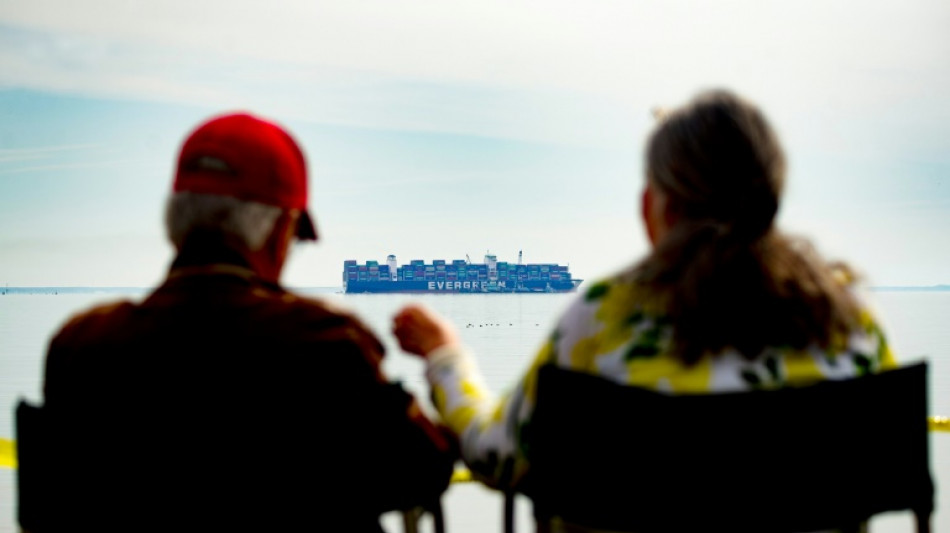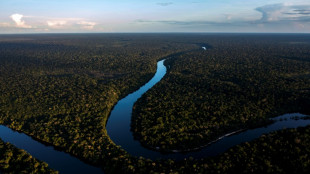

Ship stranded off US delights curious, worries environmentalists
Holding binoculars and toting folding chairs the sightseers are laser-focused: the objective is to see the massive container ship Ever Forward, which has been stranded for a month in the mud of the US East Coast's Chesapeake Bay.
Some bring their families, while others come with friends, popping a squat at the best vantage point around -- a park in the city of Pasadena, Maryland which offers an easy view of the vessel that is lodged in some 20 feet (six meters) of muck a few hundred yards from shore.
"Even with the storms we get here in the bay, we don't get ships grounding like this," said Frederick Schroeder, a retiree who traveled from nearby Baltimore with his camera and telephoto lens to document the spectacle, which he called "a once in a lifetime thing."
The hulking vessel, owned by the Taiwan-based company Evergreen, became stuck on the night of March 13 after missing a turn into deeper water.
The ship, measuring approximately 1,100 feet long and capable of carrying nearly 12,000 containers, is one of many that ply the heavily trafficked waters of the Chesapeake, a gigantic estuary whose banks harbor both the city of Baltimore and Port of Virginia, the second- and third-most substantial ports on the US East Coast.
- Tugs and dredge boats -
The Ever Forward's misadventure in the Chesapeake is reminiscent of that of the similarly named Ever Given, another Evergreen container ship which famously became stuck in a sandbank in the Suez Canal in March 2021, blocking traffic for almost a week.
The US Coast Guard has been at work trying to dislodge the Ever Forward for more than three weeks, assisted by tugs and dredge boats, but so far without success.
In recent days, cranes have surrounded the ship, laboring to unburden it of as many containers as possible to make the vessel lighter.
Asked by AFP, the Coast Guard said that a total of more than 130 containers had been unloaded so far, but that even more would be removed before a new attempt to refloat the boat -- the date for which is still to be determined.
"The skipper who ran aground, he must be beyond embarrassment to do such a thing," said John Zeglin, a nearly 80-year-old retiree who traveled to see the Ever Forward from Bethesda, Maryland, a Washington suburb about an hour's drive from the ship.
- 'Osprey abundance' -
Doug Myers, a scientist with the Chesapeake Bay Foundation, an environmental association, told AFP he was alarmed at the possibility of a hull breach, potentially releasing hundreds of gallons of fuel.
"Anytime a vessel is aground, you do have that risk," said Myers, who says he has a lot of experience with oil spills, particularly from having worked in Texas in the 1990s.
Myers also worries the ship could list and lose containers in the bay during dredging operations.
"There has been damage just by the ship running aground in shallow water -- these shallow sandbars and oyster bars contain the clams and worms and other really important fish habitats," he said.
Birds are the most vulnerable animals to an oil spill after those that live in the water, and the Ever Forward became stuck just as migrating birds stop by the bay and even nest there for summer.
"The bay is kind of the epicenter of osprey abundance," said Myers, who worries about these fish-eating birds of prey.
He said that authorities have not yet taken into account the environmental risks and wants a containment boom -- a type of protective barrier -- to be placed around the Ever Forward to prevent any oil leaks from spreading.
Even if the danger is not imminent, such a leak could reach both sides of the bay in an hour or more, he said.
"This bay is everything to Marylanders," Myers said.
"So many people make their living either directly or indirectly because of the bay, whether it be tourism, whether it be fishing, whether it be you know, just the waterfront property."
O.L.Jiminez--ESF




